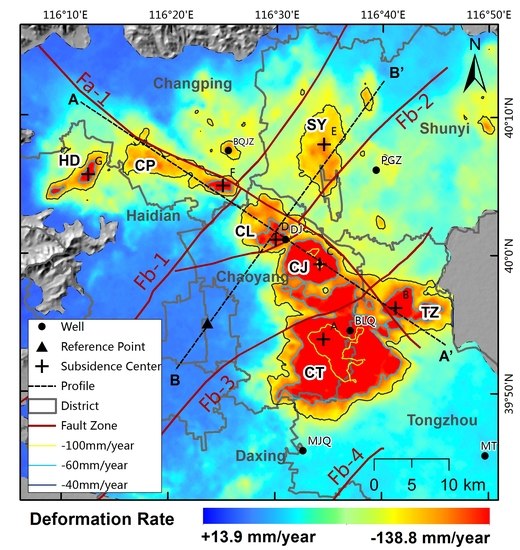Spatiotemporal Evolution of Land Subsidence in the Beijing Plain 2003–2015 Using Persistent Scatterer Interferometry (PSI) with Multi-Source SAR Data
Abstract
:1. Introduction
2. Study Area and Data Sets
2.1. Description of the Beijing Plain
2.2. Datasets Used
3. PSI Methods and Data Processing
3.1. Selection of the Master Image and Co-Registration
3.2. Interferogram Formation and PS Pixel Identification
3.3. Phase Unwrapping and Time-Series Deformation Retrieval
4. Results and Spatial Analysis
4.1. PSI-Derived Results
4.2. The Validation of the PSI Results
4.2.1. Comparison between PSI and Leveling Measurements
4.2.2. Cross-Validation between Different SAR Results
5. Discussion
5.1. Spatiotemporal Evolution of Subsidence Bowls
5.2. The Area of Different Mean Deformation Rates Region
5.3. Differential Subsidence Zone
5.4. Subsidence and Groundwater
6. Conclusions
Acknowledgments
Author Contributions
Conflicts of Interest
References
- Galloway, D.L.; Burbey, T.J. Review: Regional land subsidence accompanying groundwater extraction. Hydrogeol. J. 2011, 19, 1459–1486. [Google Scholar] [CrossRef]
- Chaussard, E.; Wdowinski, S.; Cabral-Cano, E.; Amelung, F. Land subsidence in central mexico detected by alos insar time-series. Remote Sens. Environ. 2014, 140, 94–106. [Google Scholar] [CrossRef]
- Miller, M.M.; Shirzaei, M. Spatiotemporal characterization of land subsidence and uplift in phoenix using insar time series and wavelet transforms. J. Geophys. Res. Solid Earth 2015, 120, 5822–5842. [Google Scholar] [CrossRef]
- Chen, F.; Guo, H.; Ma, P.; Lin, H.; Wang, C.; Ishwaran, N.; Hang, P. Radar interferometry offers new insights into threats to the Angkor site. Sci. Adv. 2017, 3, e1601284. [Google Scholar] [CrossRef] [PubMed]
- Syvitski, J.P.M.; Kettner, A.J.; Overeem, I.; Hutton, E.W.H.; Hannon, M.T.; Brakenridge, G.R.; Day, J.; Vörösmarty, C.; Saito, Y.; Giosan, L.; et al. Sinking deltas due to human activities. Nat. Geosci. 2009, 2, 681–686. [Google Scholar] [CrossRef]
- Tosi, L.; Da Lio, C.; Strozzi, T.; Teatini, P. Combining l- and x-band sar interferometry to assess ground displacements in heterogeneous coastal environments: The Po river delta and Venice Lagoon, Italy. Remote Sens. 2016, 8, 308. [Google Scholar] [CrossRef]
- Ng, A.H.-M.; Ge, L.; Li, X.; Zhang, K. Monitoring ground deformation in Beijing, China with persistent scatterer sar interferometry. J. Geod. 2011, 86, 375–392. [Google Scholar] [CrossRef]
- Liu, Y.; Zhang, F.; Wang, Y.; Hu, L. Research on land subsidence of recent years Beijing. Sci. Surv. Mapp. 2014, 39, 68–70. [Google Scholar]
- Haghshenas Haghighi, M.; Motagh, M. Assessment of ground surface displacement in taihape landslide, new zealand, with c- and x-band sar interferometry. N. Z. J. Geol. Geophys. 2016, 59, 136–146. [Google Scholar] [CrossRef]
- Chen, Q.; Liu, G.; Li, Y.; Ding, X. Automated detection of permanent scatterers in radar interferometry: Algrorithm and testing resrlts. Acta Geod. Cartogr. Sin. 2006, 35, 112–117. [Google Scholar]
- Liu, G.; Chen, Q.; Ding, X. Detecting ground deformation with permanent-scatterer network in radar interferometry: Algorithm and testing results. Acta Geod. Cartogr. Sin. 2007, 36, 13–18. [Google Scholar]
- Zebker, H.A.; Villasenor, J. Decorrelation in interferometric radar echoes. IEEE Trans. Geosci. Remote Sens. 1992, 30, 950–959. [Google Scholar] [CrossRef]
- Zebker, H.A.; Rosen, P.A.; Hensley, S. Atmospheric effects in interferometric synthetic aperture radar surface deformation and topographic maps. J. Geophys. Res. Solid Earth 1997, 102, 7547–7563. [Google Scholar] [CrossRef]
- Werner, C.; Wegmuller, U.; Strozzi, T.; Wiesmann, A. Interferometric point target analysis for deformation mapping. In Proceedings of the 2003 IEEE International Geoscience and Remote Sensing Symposium, IGARSS ’03, Toulouse, France, 21–25 July 2003; Volume 4367, pp. 4362–4364. [Google Scholar]
- Wegmuller, U.; Werner, C.; Strozzi, T.; Wiesmann, A. Multi-temporal interferometric point target analysis. In Proceedings of the The Second International Workshop on Analysis of Multi-Temporal Remote Sensing Images, Ispra, Italy, 16–18 July 2003; pp. 136–144. [Google Scholar]
- Ferretti, A.; Prati, C.; Rocca, F. Permanent scatterers in sar interferometry. IEEE Trans. Geosci. Remote Sens. 2001, 39, 8–20. [Google Scholar] [CrossRef]
- Zebker, H.; Shanker, P.; Hooper, A. Insar remote sensing over decorrelating terrains persistent scattering methods. In Proceedings of the IEEE Radar Conference, Waltham, MA, USA, 17–20 April 2007; pp. 717–722. [Google Scholar]
- Hooper, A.; Segall, P.; Zebker, H. Persistent scatterer interferometric synthetic aperture radar for crustal deformation analysis, with application to Volcán Alcedo, Galápagos. J. Geophys. Res. 2007, 112. [Google Scholar] [CrossRef]
- Tamburini, A.; Bianchi, M.; Giannico, C.; Novali, F. Retrieving surface deformation by psinsar™ technology: A powerful tool in reservoir monitoring. Int. J. Greenh. Gas Control 2010, 4, 928–937. [Google Scholar] [CrossRef]
- Zhang, Q.; Zhao, X.; Sun, R.; Luo, H. Land subsidence and ground fissures in xi'an, china 2005–2012 revealed by multi-band insar time-series analysis. Remote Sens. Environ. 2014, 155, 366–376. [Google Scholar]
- Solari, L.; Ciampalini, A.; Raspini, F.; Bianchini, S.; Moretti, S. Psinsar analysis in the pisa urban area (Italy): A case study of subsidence related to stratigraphical factors and urbanization. Remote Sens. 2016, 8, 120. [Google Scholar] [CrossRef]
- Chen, J.; Wu, J.; Zhang, L.; Zou, J.; Liu, G.; Zhang, R.; Yu, B. Deformation trend extraction based on multi-temporal insar in shanghai. Remote Sens. 2013, 5, 1774–1786. [Google Scholar] [CrossRef]
- Liu, G.; Luo, X.; Chen, Q.; Huang, D.; Ding, X. Detecting land subsidence in shanghai by ps-networking sar interferometry. Sensors 2008, 8, 4725–4741. [Google Scholar] [CrossRef] [PubMed]
- Liu, P.; Li, Q.; Li, Z.; Hoey, T.; Liu, G.; Wang, C.; Hu, Z.; Zhou, Z.; Singleton, A. Anatomy of subsidence in tianjin from time series insar. Remote Sens. 2016, 8, 266. [Google Scholar] [CrossRef]
- Zhu, C.; Zhang, Y.; Zhang, J.; Zhang, L.; Long, S.; Wu, H. Recent subsidence in tianjin, China: Observations from multi-looking terrasar-x insar from 2009 to 2013. Int. J. Remote Sens. 2015, 36, 5869–5886. [Google Scholar] [CrossRef]
- Guo, J.; Zhou, L.; Yao, C.; Hu, J. Surface subsidence analysis by multi-temporal insar and grace: A case study in Beijing. Sensors 2016, 16, 1495. [Google Scholar] [CrossRef] [PubMed]
- Gong, H.; Zhang, Y.; Li, X.; Lu, X.; Chen, B.; Gu, Z. Land subsidence research in Beijing based on the permanent scatterers insar technology. China Acad. J. Electron. Publ. House 2009, 19, 1261–1266. [Google Scholar]
- Zhang, Y.; Gong, H.; Gu, Z.; Wang, R.; Li, X.; Zhao, W. Characterization of land subsidence induced by groundwater withdrawals in the plain of Beijing city, China. Hydrogeol. J. 2013, 22, 397–409. [Google Scholar] [CrossRef]
- Chen, M.; Tomás, R.; Li, Z.; Motagh, M.; Li, T.; Hu, L.; Gong, H.; Li, X.; Yu, J.; Gong, X. Imaging land subsidence induced by groundwater extraction in Beijing (China) using satellite radar interferometry. Remote Sens. 2016, 8, 468. [Google Scholar] [CrossRef]
- Li, Y.; Zhang, J.; Li, Z.; Luo, Y. Land subsidence in Beijing city from insar time series analysis with small baseline subset. Geom. Inf. Sci. Wuhan Univ. 2013, 38, 1374–1377. [Google Scholar]
- Zhu, L.; Gong, H.; Li, X.; Wang, R.; Chen, B.; Dai, Z.; Teatini, P. Land subsidence due to groundwater withdrawal in the northern Beijing plain, China. Eng. Geol. 2015, 193, 243–255. [Google Scholar] [CrossRef]
- Hu, B.; Wang, H.-S.; Sun, Y.-L.; Hou, J.-G.; Liang, J. Long-term land subsidence monitoring of Beijing (China) using the small baseline subset (SBAS) technique. Remote Sens. 2014, 6, 3648–3661. [Google Scholar] [CrossRef]
- Zhang, Y.; Wu, H.A.; Kang, Y.; Zhu, C. Ground subsidence in the Beijing-tianjin-hebei region from 1992 to 2014 revealed by multiple sar stacks. Remote Sens. 2016, 8, 675. [Google Scholar] [CrossRef]
- Yang, Y.; Luo, Y.; Liu, M.; Wang, R.; Wang, H. Research of features related to land subsidence and ground fissure disasters in the Beijing plain. Proc. Int. Assoc. Hydrol. Sci. 2015, 372, 239–242. [Google Scholar] [CrossRef]
- Beijing Geology and Mineral Resources Exploration and Development Bureau; Hydrogeology and Engineering Geology Team of Beijing. Physical Geography and Regional Geological Settings. Groundwater of Beijing; China Land Publishing House: Beijing, China, 2008; pp. 1–23.
- Zhang, Y.; Ma, Y.; Nong, Y.; Wei, S.; Dong, S. Cenozoic extensional stress evolution in north china. J. Geodyn. 2003, 36, 591–613. [Google Scholar]
- Zhang, Y.G.; Zheng, W.J.; Wang, Y.J.; Zhang, D.L.; Tian, Y.T.; Wang, M.; Zhang, Z.Q.; Zhang, P.Z. Contemporary deformation of the north china plain from global positioning system data. Geophys. Res. Lett. 2018, 45, 1851–1859. [Google Scholar] [CrossRef]
- Wang, Z.; Cai, X.; Yan, J.; Wang, J.; Liu, Y.; Zhang, L. Using the integrated geophysical methods detecting active faults: A case study in beijing, china. J. Appl. Geophys. 2017. [Google Scholar] [CrossRef]
- Liu, S. Magnetostratigraphic research on the structural activeties of the faults in the beiqijia area of beijing plain. Master's Thesis, University of Geosciences, Beijing, China, 2013. [Google Scholar]
- Zhang, L.; Bai, L.; Cai, X.; Wang, J.; Liu, Y.; He, F.; Wang, Z.; He, J. An analysis of the activity of the northwest part of nankou-sunhe fault. Geol. China 2014, 41, 902–911. [Google Scholar]
- Jiao, Q.; Qiu, Z. Research progress of major active faults. Bull. Inst. Crustal Dyn. 2006, 78–90. [Google Scholar]
- Zhao, Y.; Cai, X.M.; Wang, J.M.; Zhang, L.; Liu, Y.; Lv, J.B. The division of“small blocks”of structure in beijing plain and a discussion on the activity of micro block in quaternary period. Geol. China 2015, 6, 1807. [Google Scholar]
- Kampes, B.M.; Adam, N. Velocity field retrieval from long term coherent points in radar interferometric stacks. In Proceedings of the 2003 IEEE International Geoscience and Remote Sensing Symposium (IGARSS 2003), Toulouse, France, 21–25 July 2003; Volume 942, pp. 941–943. [Google Scholar]
- Hsu, W.-C.; Chang, H.-C.; Chang, K.-T.; Lin, E.-K.; Liu, J.-K.; Liou, Y.-A. Observing land subsidence and revealing the factors that influence it using a multi-sensor approach in Yunlin county, Taiwan. Remote Sens. 2015, 7, 8202–8223. [Google Scholar] [CrossRef]
- Hooper, A. Statistical-cost approach to unwrapping the phase of insar time series. In Proceeding of the 2010 International Workshop on ERS SAR Interferometry, Frascati, Italy, 30 November–4 December 2010; pp. 1–5. [Google Scholar]
- He, Q.-C.; Liu, W.-B.; Li, Z.-M. Land subsidence survey and monitoring in the north China plain. Geol. J. China Univ. 2006, 12, 195–209. [Google Scholar]
- Casu, F.; Manzo, M.; Lanari, R. A quantitative assessment of the sbas algorithm performance for surface deformation retrieval from dinsar data. Remote Sens. Environ. 2006, 102, 195–210. [Google Scholar] [CrossRef]
- Chen, F.; Wu, Y.; Zhang, Y.; Parcharidis, I.; Ma, P.; Xiao, R.; Xu, J.; Zhou, W.; Tang, P.; Foumelis, M. Surface motion and structural instability monitoring of ming dynasty city walls by two-step tomo-psinsar approach in Nanjing city, China. Remote Sens. 2017, 9, 371. [Google Scholar] [CrossRef]
- Deng, Z.; Ke, Y.; Gong, H.; Li, X.; Li, Z. Land subsidence prediction in Beijing based on ps-insar technique and improved grey-markov model. Gisci. Remote Sens. 2017, 54, 797–818. [Google Scholar] [CrossRef]
- Zhao, H.; Fan, J.; Guo, X.; Chen, J.; Xia, Y.; Ge, D.; Zhang, L.; Qiu, Y.; Zhong, C. Detection of land subsidence in Beijing, China, using interferometric point target analysis technique. In Proceedings of the Geoscience and Remote Sensing Symposium, Honolulu, HI, USA, 25–30 July 2010; pp. 1553–1556. [Google Scholar]
- Gao, M.; Gong, H.; Chen, B.; Zhou, C.; Chen, W.; Liang, Y.; Shi, M.; Si, Y. Insar time-series investigation of long-term ground displacement at Beijing capital international airport, China. Tectonophysics 2016, 691, 271–281. [Google Scholar] [CrossRef]
- Zhou, C.; Gong, H.; Chen, B.; Li, J.; Gao, M.; Zhu, F.; Chen, W.; Liang, Y. Insar time-series analysis of land subsidence under different land use types in the eastern Beijing plain, China. Remote Sens. 2017, 9, 380. [Google Scholar] [CrossRef]
- Chen, J.; Gao, J.; Chen, W. Urban land expansion and the transitional mechanisms in Nanjing, China. Habitat Int. 2016, 53, 274–283. [Google Scholar] [CrossRef]
- Zhang, Z.; Jia, D.; Deng, S.; Jin, X. Quantitative research of urban spatial morphology: A case study of the main urban zone of Chongqing. J. Geo-Inf. Sci. 2013, 15, 297–306. [Google Scholar] [CrossRef]
- Cigna, F.; Del Ventisette, C.; Liguori, V.; Casagli, N. Advanced radar-interpretation of insar time series for mapping and characterization of geological processes. Nat. Hazards Earth Syst. Sci. 2011, 11, 865–881. [Google Scholar] [CrossRef] [Green Version]
- Terzaghi, K. Settlement and consolidation in clay. Eng. News Rec. 1925, 95, 874–878. [Google Scholar]

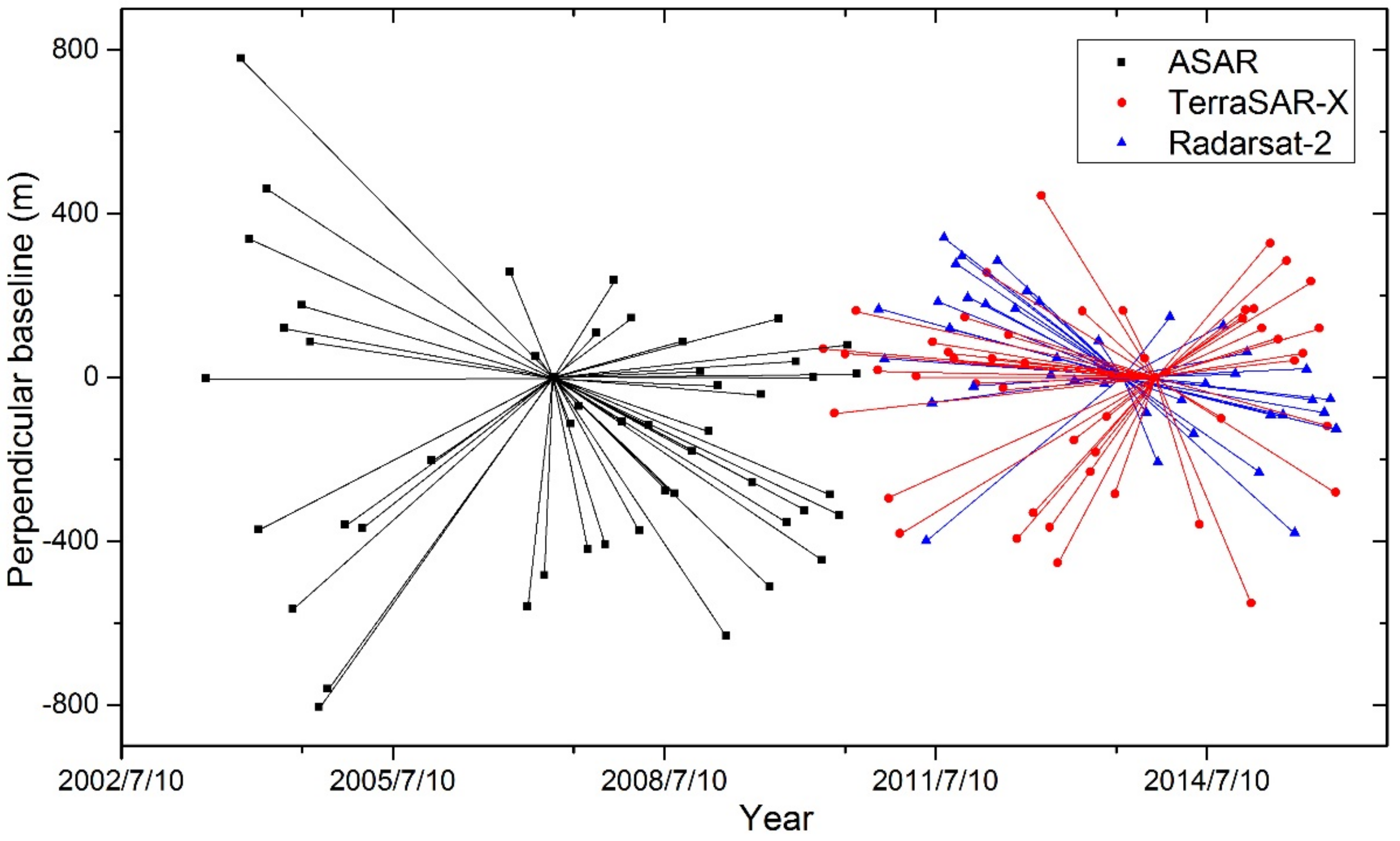

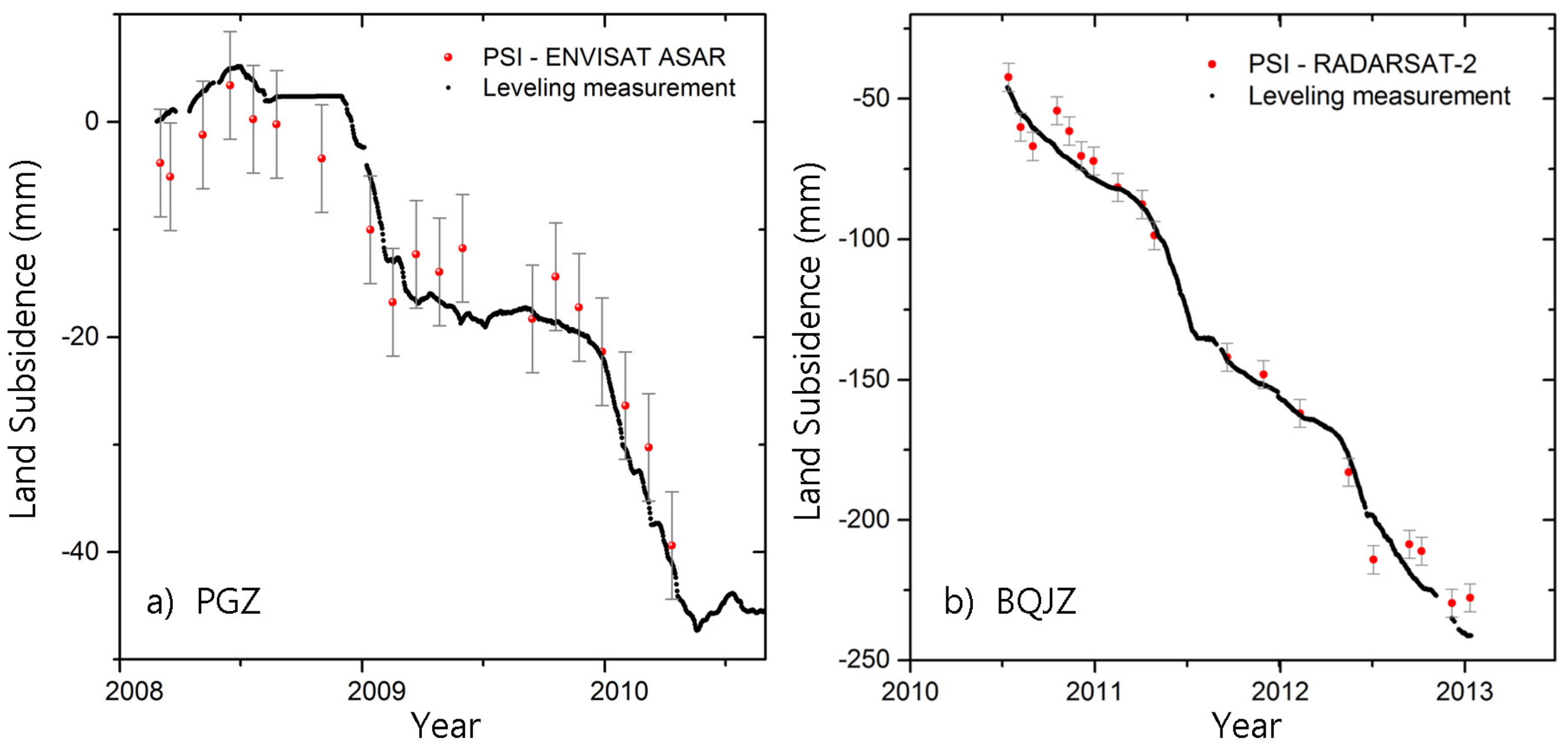
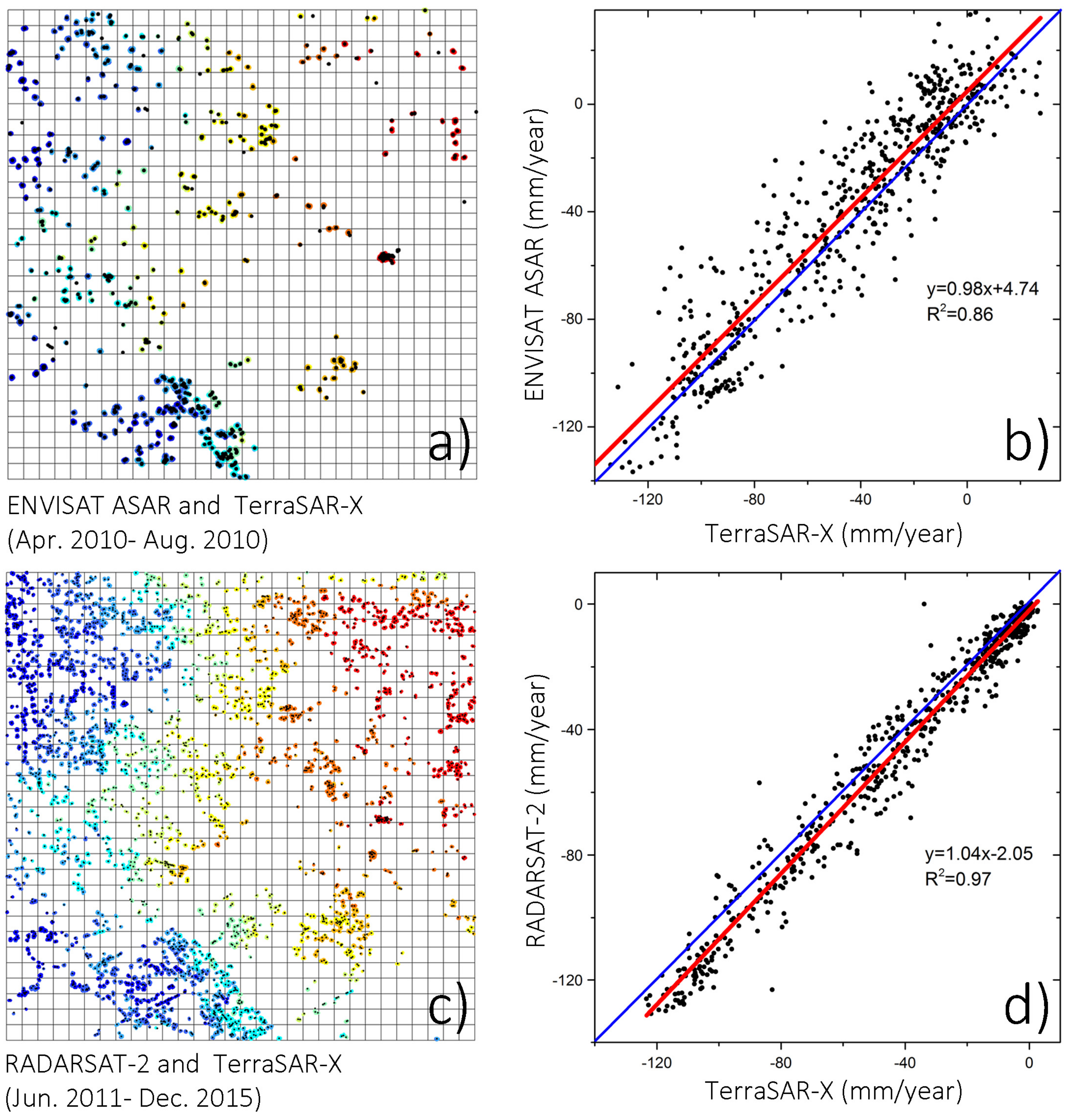

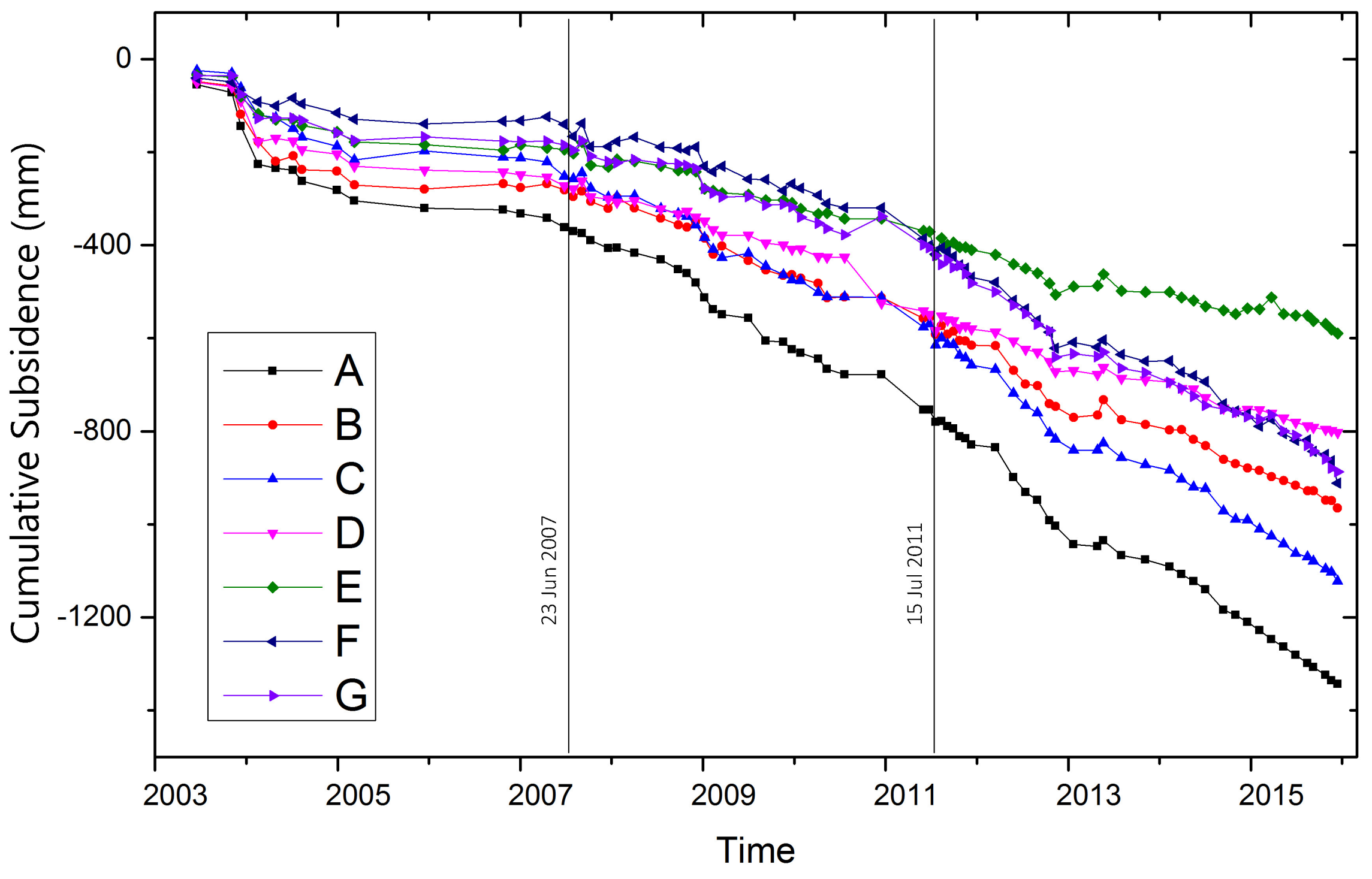
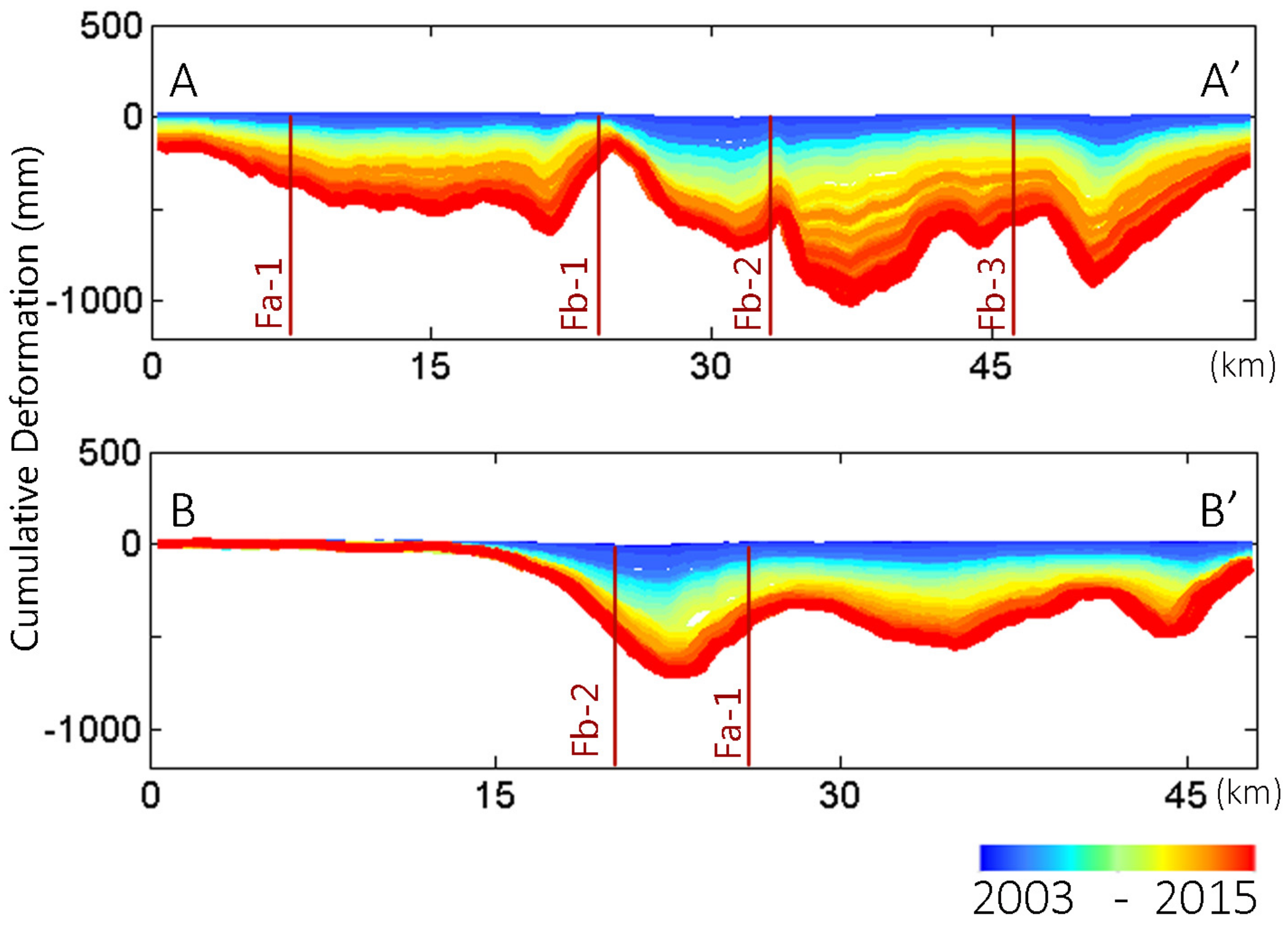

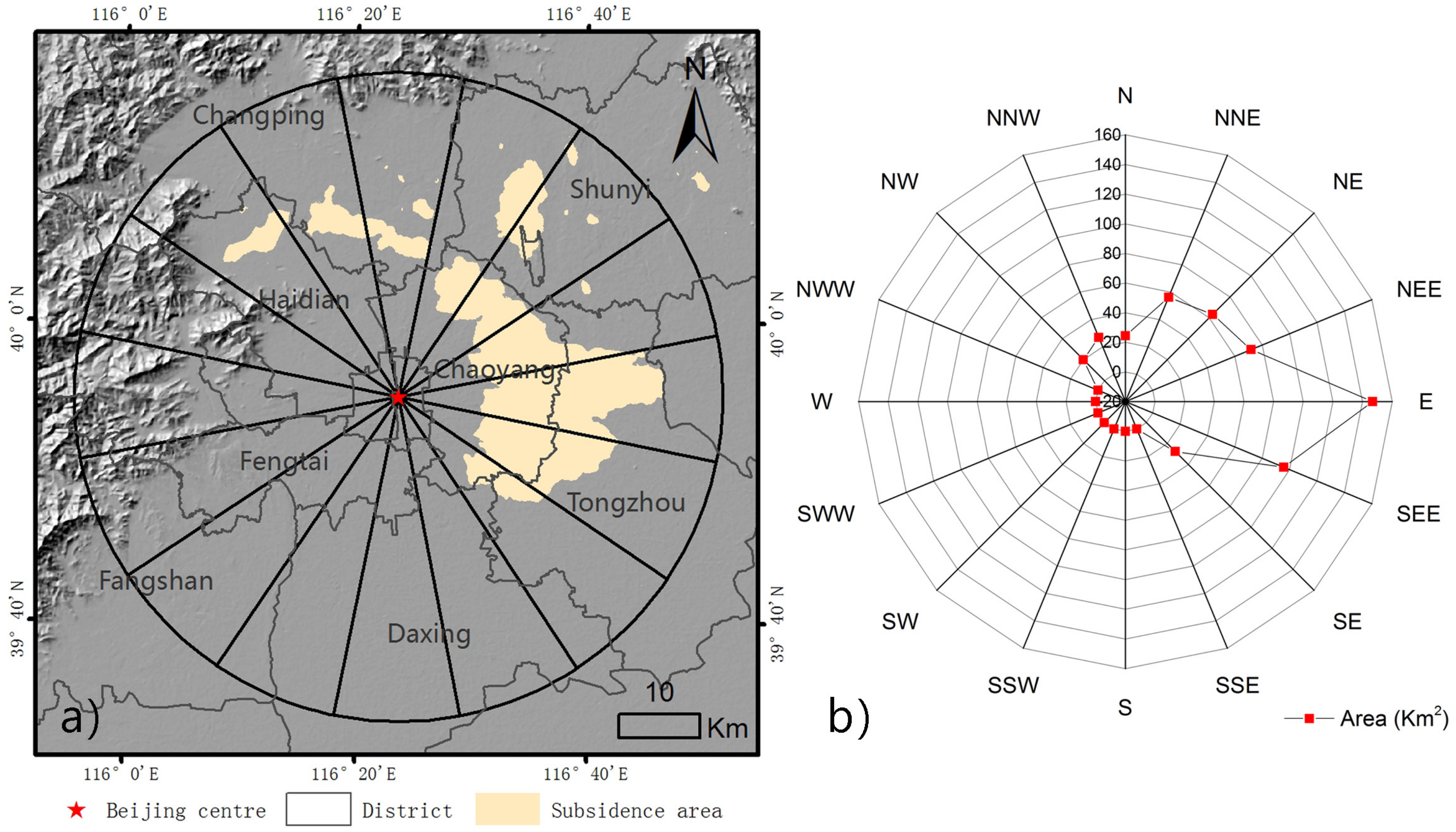
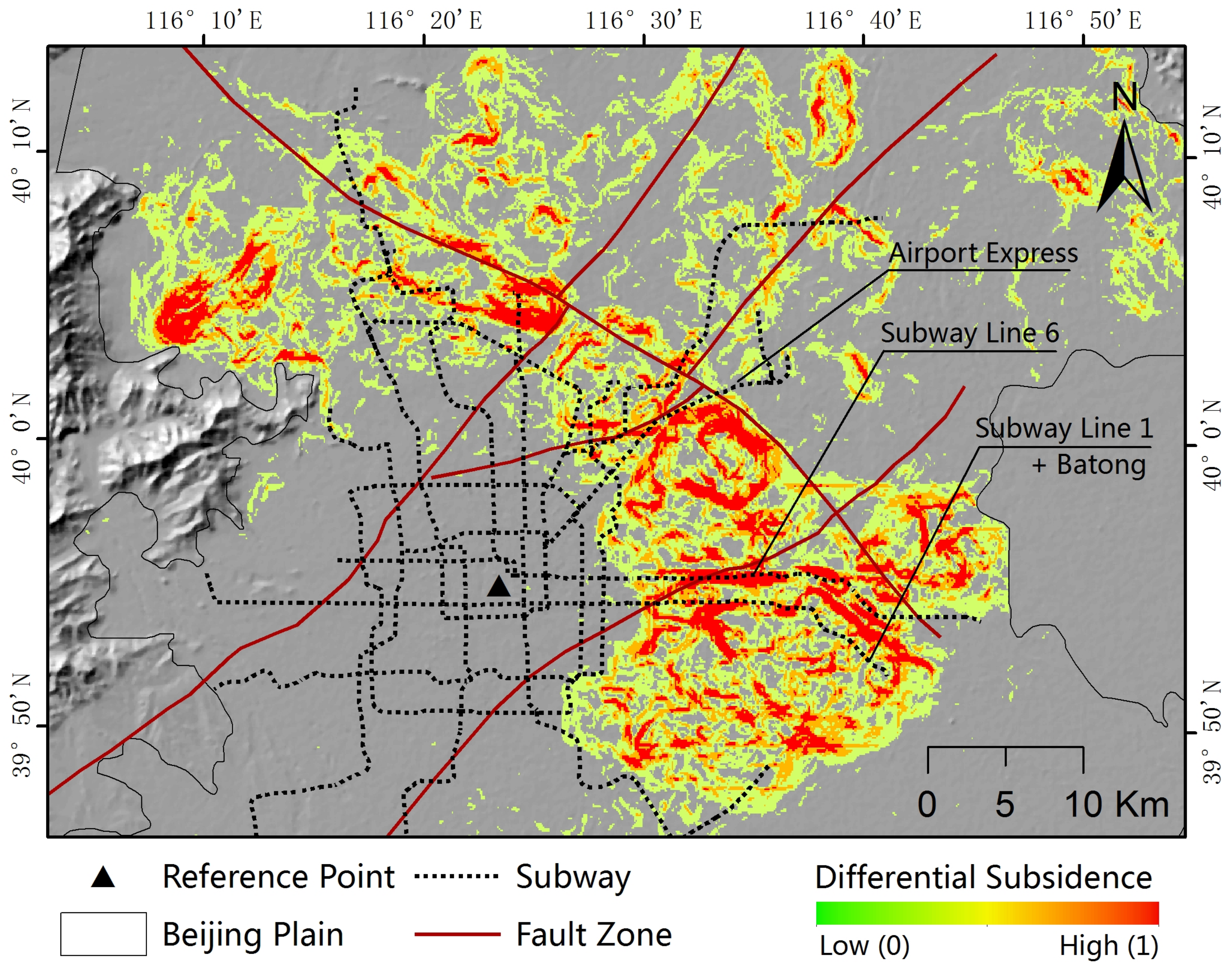
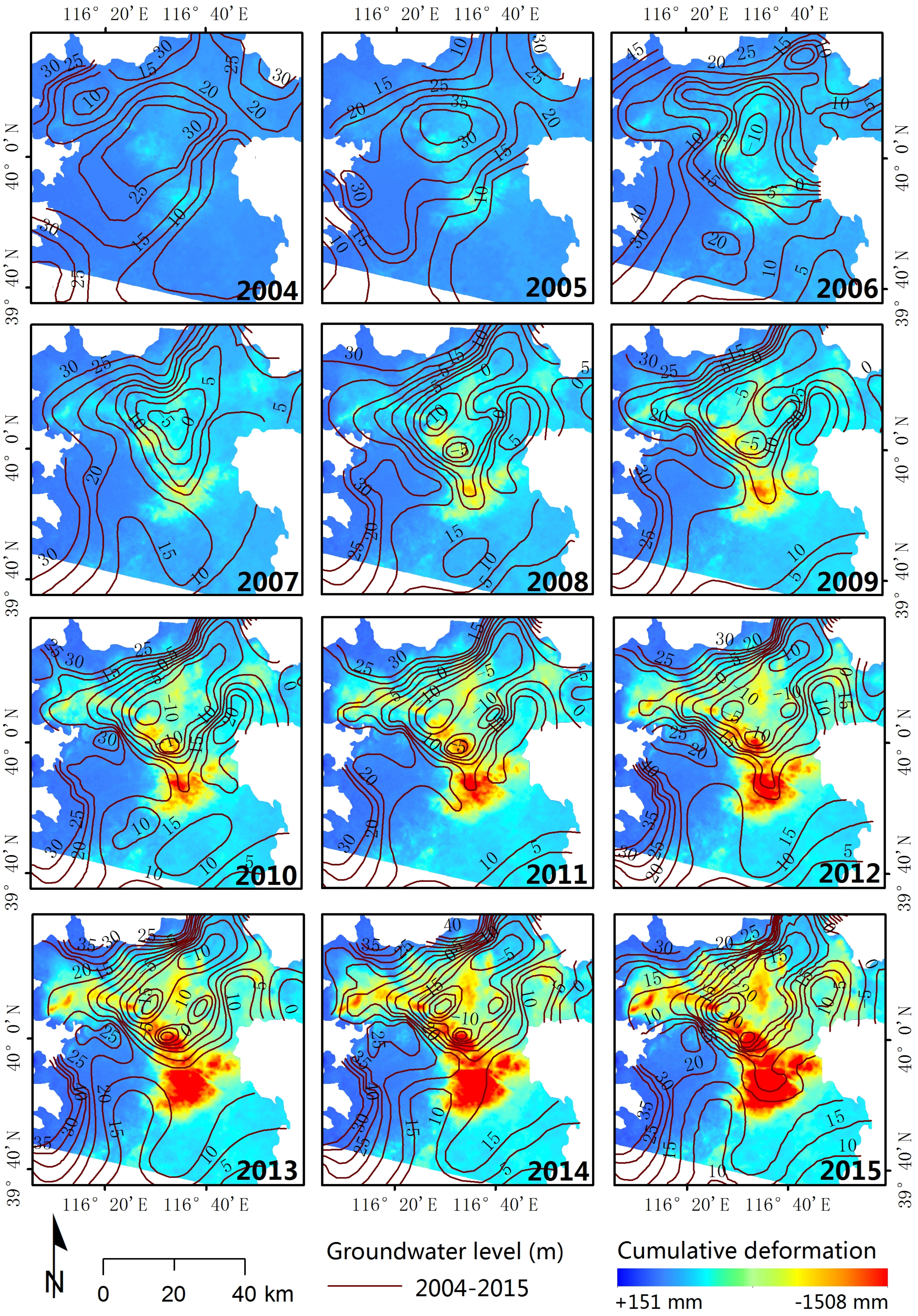

| Parameter | ENVISAT ASAR | RADARSAT-2 | TerraSAR-X |
|---|---|---|---|
| Band | C | C | X |
| Wavelength (cm) | 5.6 | 5.5 | 3.1 |
| Polarization | VV | VV | HH |
| Orbit directions | Descending | Descending | Ascending |
| Track No. | 2218 | 60115 | 8 |
| Incidence angle (°) | 22.9 | 27.6 | 33.1 |
| Heading (°) | −164 | −168.8 | −10 |
| Spatial resolution (m) | 30 | 30 | 3 |
| No. of images | 48 | 40 | 51 |
| Date range | June 2003–August 2010 | June 2011–December 2015 | April 2010–December 2015 |
| Direction | Expanding Area (km2) | Rate (km2/Year) | Direction | Expanding Area (km2) | Rate (km2/Year) |
|---|---|---|---|---|---|
| N | 24.46 | 1.88 | S | 0 | 0 |
| NNE | 56.32 | 4.33 | SSW | 0 | 0 |
| NE | 63.26 | 4.87 | SW | 0 | 0 |
| NEE | 71.81 | 5.52 | SWW | 0 | 0 |
| E | 146.87 | 11.30 | W | 0 | 0 |
| SEE | 95.66 | 7.36 | NWW | 0 | 0 |
| SE | 27.53 | 2.12 | NW | 20.11 | 1.55 |
| SSE | 0 | 0 | NNW | 26.93 | 2.07 |
© 2018 by the authors. Licensee MDPI, Basel, Switzerland. This article is an open access article distributed under the terms and conditions of the Creative Commons Attribution (CC BY) license (http://creativecommons.org/licenses/by/4.0/).
Share and Cite
Zhou, C.; Gong, H.; Zhang, Y.; Warner, T.A.; Wang, C. Spatiotemporal Evolution of Land Subsidence in the Beijing Plain 2003–2015 Using Persistent Scatterer Interferometry (PSI) with Multi-Source SAR Data. Remote Sens. 2018, 10, 552. https://doi.org/10.3390/rs10040552
Zhou C, Gong H, Zhang Y, Warner TA, Wang C. Spatiotemporal Evolution of Land Subsidence in the Beijing Plain 2003–2015 Using Persistent Scatterer Interferometry (PSI) with Multi-Source SAR Data. Remote Sensing. 2018; 10(4):552. https://doi.org/10.3390/rs10040552
Chicago/Turabian StyleZhou, Chaodong, Huili Gong, Youquan Zhang, Timothy A. Warner, and Cong Wang. 2018. "Spatiotemporal Evolution of Land Subsidence in the Beijing Plain 2003–2015 Using Persistent Scatterer Interferometry (PSI) with Multi-Source SAR Data" Remote Sensing 10, no. 4: 552. https://doi.org/10.3390/rs10040552




